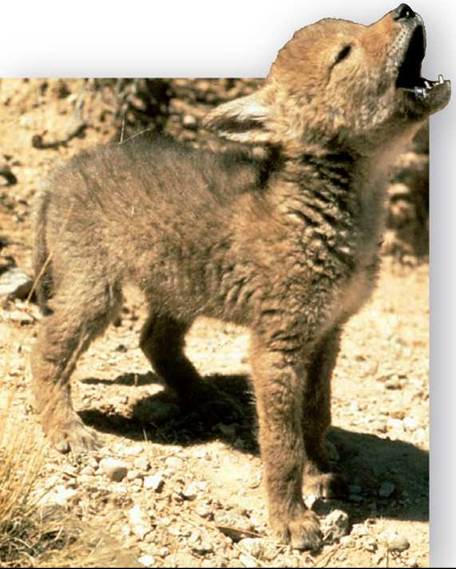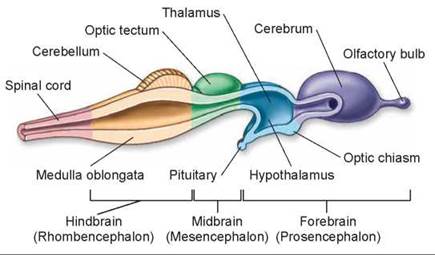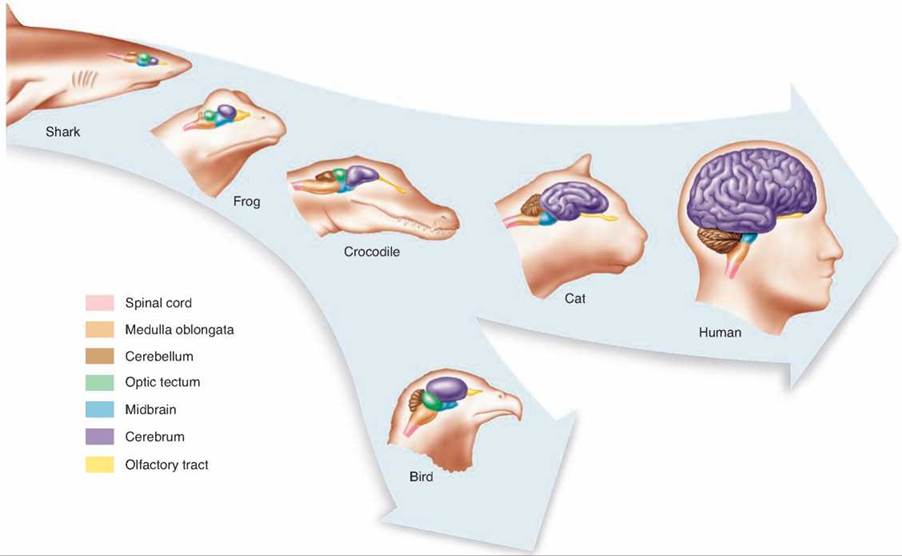THE LIVING WORLD
Unit Six. Animal Life
28.5. Evolution of the Vertebrate Brain
The structure and function of the vertebrate brain have long been the subject of scientific inquiry. Despite ongoing research, scientists are still not sure how the brain performs many of its functions. For instance, scientists continue to look for the mechanism the brain employs to store memories, and they do not understand how some memories can be “locked away,” only to surface in times of stress. The brain is the most complex vertebrate organ ever to evolve, and it can perform a bewildering variety of complex functions (figure 28.8).

Figure 28.8. Singing well takes practice.
This baby coyote is greeting the approaching evening. His howling is not as impressive as his dad's—a good performance takes practice. His brain is learning by repetition how to control the vocal cords.
Casts of the interior braincases of fossil agnathans, fishes that swam 500 million years ago, have revealed much about the early evolutionary stages of the vertebrate brain. Although small, these brains already had the three divisions, shown in figure 28.9, that characterize the brains of all contemporary vertebrates: (1) the hindbrain, or rhombencephalon (colored yellow); (2) the midbrain, or mesencephalon (colored green); and (3) the forebrain, or prosencephalon (colored blue and purple).

Figure 28.9. The brain of a primitive fish.
The basic organization of the vertebrate brain can be seen in the brains of primitive fishes. The brain is divided into three regions that are found in differing proportions in all vertebrates: the hindbrain, which is the largest portion of the brain in fishes; the midbrain, which in fishes is devoted primarily to processing visual information; and the forebrain, which is concerned mainly with olfaction (the sense of smell) in fishes. In terrestrial vertebrates, the forebrain plays a far more dominant role in neural processing than it does in fishes.
The hindbrain was the major component of these early brains, as it still is in fishes today. Composed of the cerebellum and medulla oblongata, the fish hindbrain may be considered an extension of the spinal cord devoted primarily to coordinating motor reflexes. Tracts containing large numbers of axons run like cables up and down the spinal cord to the hindbrain. The hindbrain integrates the many sensory signals coming from the muscles and coordinates the pattern of motor responses.
Much of this coordination is carried on within a small extension of the hindbrain called the cerebellum (“little cerebrum”). In more advanced vertebrates, the cerebellum plays an increasingly important role as a coordinating center and is correspondingly larger than it is in the fishes. In all vertebrates, the cerebellum processes data on the current position and movement of each limb, the state of relaxation or contraction of the muscles involved, and the general position of the body and its relation to the outside world. These data are gathered in the cerebellum and synthesized, and the resulting commands are issued to efferent pathways.
In fishes, the remainder of the brain is devoted to the reception and processing of sensory information. The midbrain is composed primarily of the optic lobes (also called the optic tectum), which receive and process visual information, while the forebrain is devoted to the processing of olfactory (smell) information. The brains of fishes continue growing throughout their lives. This continued growth is in marked contrast to the brains of other classes of vertebrates, which generally complete their development by infancy. The human brain continues to develop through early childhood, but no new neurons are produced once development has ceased, except in the hippocampus, involved in long-term memory.
The Dominant Forebrain
Starting with the amphibians and continuing more prominently in the reptiles, sensory information is increasingly centered in the forebrain. This pattern was the dominant evolutionary trend in the further development of the vertebrate brain. The areas of the brain are color-coded in figure 28.10 so that you can follow this trend in brain development, with the cerebrum of the forebrain becoming larger in mammals.

Figure 28.10. The evolution of the vertebrate brain.
In sharks and other fishes, the hindbrain is predominant, and the rest of the brain serves primarily to process sensory information. In amphibians and reptiles, the forebrain is far larger, and it contains a larger cerebrum devoted to associative activity. In birds, which evolved from reptiles, the cerebrum is even more pronounced. In mammals, the cerebrum covers the optic tectum and is the largest portion of the brain. The dominance of the cerebrum is greatest in humans, where it envelops much of the rest of the brain.
The forebrain in reptiles, amphibians, birds, and mammals is composed of two elements: the diencephalon and the telencephalon. The diencephalon consists of the thalamus and hypothalamus (colored blue in figure 28.9). The thalamus is an integrating and relay center between incoming sensory information and the cerebrum. The hypothalamus participates in basic drives and emotions and controls the secretions of the pituitary gland, which in turn regulates many of the other endocrine glands of the body (see chapter 30). Through its connections with the nervous system and endocrine system, the hypothalamus helps coordinate the neural and hormonal responses to many internal stimuli and emotions. The telencephalon, or “end brain,” is located at the front of the forebrain and is devoted largely to associative activity (colored purple in figures 28.9 and 28.10). In mammals, the telencephalon is called the cerebrum.
The Expansion of the Cerebrum
If you examine the relationship between brain size and body size in the animals pictured in figure 28.10, you can see a remarkable difference between fishes, amphibians, and reptiles (to the left of the branch point in the figure), and birds and mammals (to the right of the branch point in the figure). Mammals in particular have brains that are particularly large relative to their body size. This is especially true of porpoises and humans. The increase in brain size in mammals largely reflects the great enlargement of the cerebrum, the dominant part of the mammalian brain. The cerebrum is the center for correlation, association, and learning in the mammalian brain. It receives sensory data from throughout the body and issues motor commands to the body.
Key Learning Outcome 28.5. In fishes, the hindbrain forms much of the brain; as terrestrial vertebrates evolved, the forebrain became increasingly more prominent.